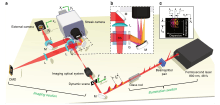Femto-photography
Femto-photography is a technique for recording the propagation of ultrashort pulses of light through a scene at a very high speed (up to 1013 frames per second). A femto-photograph is equivalent to an optical impulse response of a scene and has also been denoted by terms such as a light-in-flight recording[1] or transient image.[2][3] Femto-photography of macroscopic objects was first demonstrated using a holographic process in the 1970s by Nils Abramsson at the Royal Institute of Technology (Sweden).[1] A research team at the MIT Media Lab led by Ramesh Raskar, together with contributors from the Graphics and Imaging Lab at the Universidad de Zaragoza, Spain, more recently achieved a significant increase in image quality using a streak camera synchronized to a pulsed laser and modified to obtain 2D images instead of just a single scanline.[4][5]

In their publications, Raskar's team claims to be able to capture exposures so short that light only traverses 0.6 mm (corresponding to 2 picoseconds, or 2×10−12 seconds) during the exposure period,[6] a figure that is in agreement with the nominal resolution of the Hamamatsu streak camera model C5680,[7][8] on which their experimental setup is based.[9] Recordings taken using the setup have reached significant spread in the mainstream media, including a presentation by Raskar at TEDGlobal 2012.[10] Furthermore, the team was able to demonstrate the reconstruction of unknown objects "around corners", i.e., outside the line of sight of light source and camera, from femto-photographs.[9]
In 2013, researchers at the University of British Columbia demonstrated a computational technique that allows the extraction of transient images from time-of-flight sensor data without the need for ultrafast light sources or detectors.[11]
Other uses of the term
Prior to the aforementioned work, the term "femto-photography" had been used for certain proposed procedures in experimental nuclear physics.[12]
References
- Abramsson, Nils (1978). "Light-in-flight recording by holography". Optics Letters. 3 (4): 121–123. Bibcode:1978OptL....3..121A. doi:10.1364/OL.3.000121. PMID 19684717.
- Smith, Adam; James Skorupski; James Davis (2008). "Transient Rendering". Technical Report, School of Engineering, University of California Santa Cruz. UCSC-SOE-08-26. Retrieved 31 July 2014.
- Kirmani, A.; Hutchison, T.; Davis, J.; Raskar, R. (2009). Looking around the corner using transient imaging. IEEE 12th International Conference on Computer Vision. pp. 159–166. CiteSeerX 10.1.1.308.3180. doi:10.1109/ICCV.2009.5459160. ISBN 978-1-4244-4420-5.
- Velten, Andreas; Lawson, Everett; Bardagjy, Andrew; Bawendi, Moungi; Raskar, Ramesh (2011-12-13). "Slow art with a trillion frames per second camera". Visualizing Light at Trillion FPS, Camera Culture, MIT Media Lab. Web.media.mit.edu. p. 1. doi:10.1145/2037715.2037730. ISBN 9781450309714. Retrieved 2012-10-04.
- Velten, Andreas; Di Wu; Adrian Jarabo; Belen Masia; Christopher Barsi; Chinmaya Joshi; Everett Lawson; Moungi Bawendi; Diego Gutierrez; Ramesh Raskar (July 2013). "Femto-Photography: Capturing and Visualizing the Propagation of Light" (PDF). ACM Transactions on Graphics. 32 (4). doi:10.1145/2461912.2461928. hdl:1721.1/82039. Retrieved 21 November 2013.
- Velten, Andreas; Lawson, Everett; Bardagjy, Andrew; Bawendi, Moungi; Raskar, Ramesh (2011). "Slow art with a trillion frames per second camera". ACM SIGGRAPH 2011 Posters on - SIGGRAPH '11. Dl.acm.org. p. 1. doi:10.1145/2037715.2037730. ISBN 9781450309714.
- Hamamatsu Corporation. "Universal Streak Camera C5680 Series - Measurements Ranging From X-Ray to Near Infrared With a Temporal Resolution of 2 ps". Retrieved 2013-11-22.
- Information from alldatasheet.com
- Velten, Andreas; Thomas Willwacher; Otkrist Gupta; Ashok Veeraraghavan; Moungi G. Bawendi; Ramesh Raskar (20 March 2012). "Recovering three-dimensional shape around a corner using ultrafast time-of-flight imaging". Nature Communications. 3: 745. Bibcode:2012NatCo...3..745V. CiteSeerX 10.1.1.434.2312. doi:10.1038/ncomms1747. PMID 22434188.
- TEDGlobal 2012. "Ramesh Raskar: Imaging at a trillion frames per second | Video on". Ted.com. Retrieved 2012-10-04.
- Heide, Felix; Matthias B. Hullin; James Gregson; Wolfgang Heidrich. "Low-Budget Transient Imaging using Photonic Mixer Devices". In: ACM Trans. Graph. 32(4) (Proc. SIGGRAPH 2013). Retrieved 22 November 2013.
- Nucleon hologram with exclusive leptoproduction. Exclusive Processes at High Momentum Transfer. World Scientific. May 15–18, 2002. ISBN 9789812382559. Retrieved 4 October 2012.